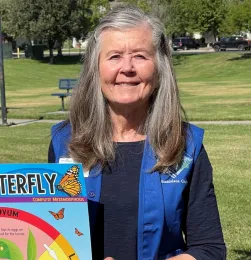
Life Cycle
Like all butterflies, Monarch butterflies have four life stages:
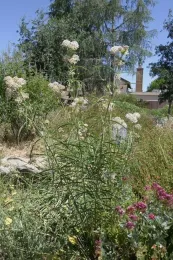
- Egg: The female Monarch lays her eggs on their sole host plant, the milkweed (Asclepias). She generally lays one egg per plant. Each egg is about the size of a grain of salt.
- Larva (Caterpillar): After 3 – 5 days, the Monarch egg hatches to a larva, also called a caterpillar, eating only milkweed leaves. They go through five instar stages over a period of 10 – 14 days as they grow from 1/16th of an inch to about two inches, molting their exoskeleton at each stage.
- Pupa: The caterpillar finds a protected place to develop its chrysalis for the pupal stage. During the next 11-15 days the pupa will change to an adult by liquifying its body while inside the chrysalis, ultimately emerging to the adult butterfly.
- Adult: In the final hours before emergence, the chrysalis becomes translucent, a crack will appear, with the Monarch butterfly freeing itself from the case. Hanging from the now-empty chrysalis case, it will spend the next few hours pumping fluid into its wings until they are firm enough to fly. Eventually it will take flight and start seeking out nectar for its 1st meal. Adult Monarch butterflies feed on flowers, which makes them pollinators. The nectar provides energy for flight, mating, and migration.
Milkweed
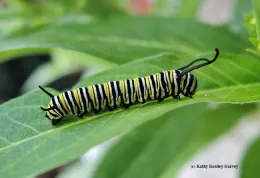
Migration
The Monarch migration is extraordinary with none quite like it in the butterfly world. A Monarch butterfly begins an epic one-way journey south up to 2,800 miles to a specific place where they have never been to before, where their great-grandparent spent the previous winter. It remains largely a mystery how successive generations know the route and where to spend the winter months.
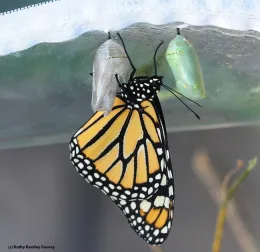
Late in summer or early fall, a final generation emerges. Triggered by changes in temperature and sunlight, this generation will migrate south. Known as the “Methuselah” generation (after the biblical patriarch said to have lived 969 years), they can live up to 6 – 8 months. They do not emerge as sexually mature butterflies, being in a “sexual diapause,” so their energies can be focused on developing flight muscles and storing lipids for their long journey south and surviving the winter months.
Come spring, with warming temperatures and longer days, these butterflies will become sexually mature, feed on nectar, mate, and start moving northward, laying eggs, which will hatch to continue the annual migration cycle.
You may see migrating Monarchs this fall in your garden feeding on nectar flowers, resting on flat flowers or rocks, or drinking from water sources. Admire them, but leave them be, since they still have some distance to go to reach their wintering grounds. In California, their wintering spots are along coastal areas from Monterey area (Pacific Grove) to San Diego.
Monarchs in Trouble
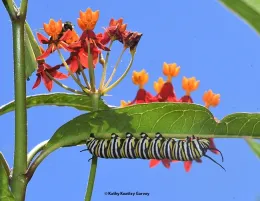
In temperate areas like the Central Valley, the tropical milkweed plant (Asclepias currasavica) does not go dormant. A parasite that lives on the plant is ingested by developing caterpillars and is linked lower migration success and reductions in lifespan. Choose milkweed species that goes through winter dormancy such as narrowleaf milkweed and showy milkweed (A. fasicularis and speciosa.)
The IUCN announcement states: "The western population is at greatest risk of extinction, having declined by an estimated 99.9%, from as many as 10 million to 1,914 butterflies between the 1980s and 2021.” In addition, "The larger eastern population also shrunk by 84% from 1996 to 2014. Concern remains as to whether enough butterflies survive to maintain the populations and prevent extinction."
Sign up for our Free Class!
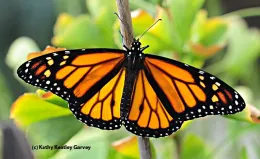
Date: Saturday, October 15, 2022
Time: 9:00 am – 10:30 am
Where: Stanislaus Agricultural Center, 1800 Cornucopia Way, Harvest Hall
Register: http://ucanr.edu/monarchs/2022
---------------------------------------------------
Resources:
- Art Shapiro's Butterfly Site https://butterfly.ucdavis.edu/butterflies
- Butterflies in Your Garden https://ucanr.edu/sites/CEStanislausCo/files/345791.pdf
- Xerces Society - Pollinator Plants: California https://xerces.org/publications/plant-lists/pollinator-plants-California
- UC Davis Arboretum – Larval Hosts for Butterflies https://arboretum.ucdavis.edu/blog/larval-host-plants-butterflies
- California Native Plant Society – Native Planting Guides https://www.cnps.org/gardening/choosing-your-plants/native-planting-guides
- Tropical Milkweed - a no grow https://xerces.org/blog/tropical-milkweed-a-no-grow
- Calscape CA native plants https://www.calscape.org/
- UC ANR Bug Squad Blog https://ucanr.edu/blogs/bugsquad/
- International Union for Conservation of Nature (IUCN) https://www.iucn.org/
- The Monarch: Saving Our Most Beloved Butterfly, by Kylee Baumle, St. Lynn's PressMilkweed Poisoning: https://www.poison.org/articles/milkweed-can-cause-serious-poisoning-204

